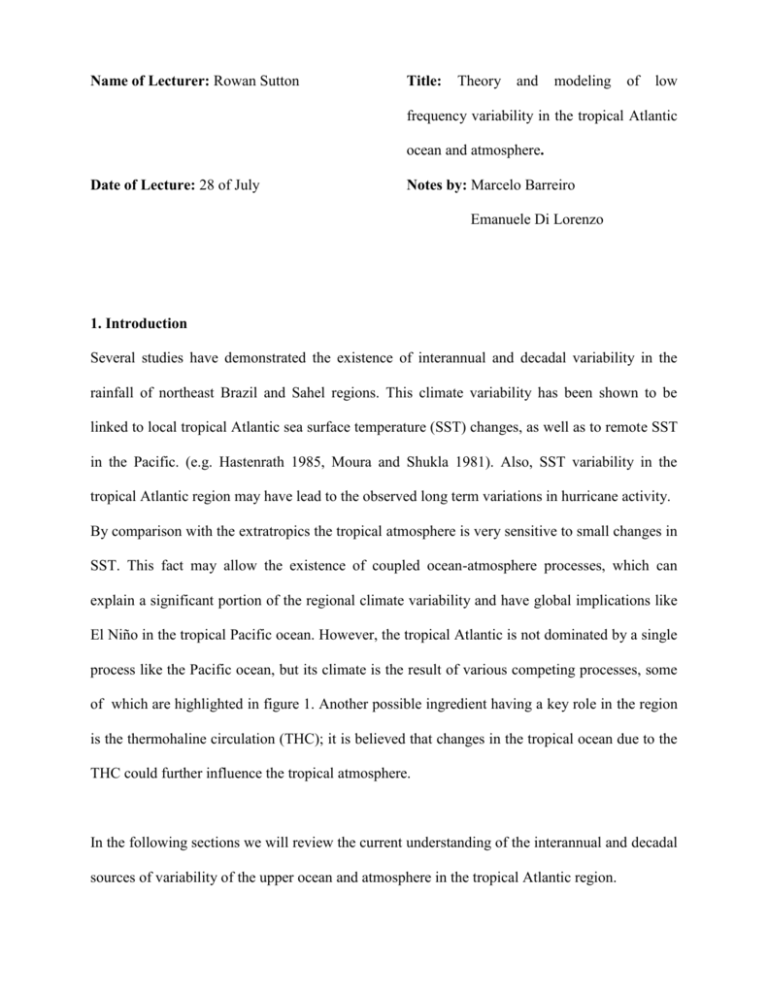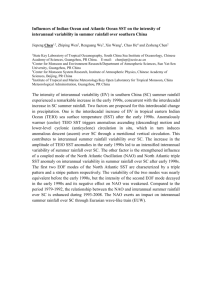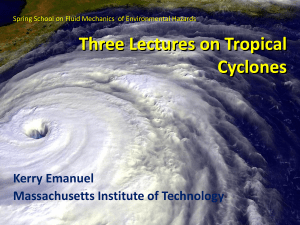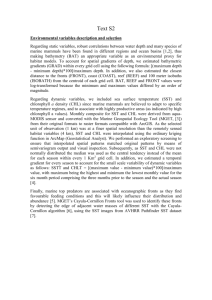Variability of the atmosphere in the tropical Atlantic region
advertisement

Name of Lecturer: Rowan Sutton Title: Theory and modeling of low frequency variability in the tropical Atlantic ocean and atmosphere. Date of Lecture: 28 of July Notes by: Marcelo Barreiro Emanuele Di Lorenzo 1. Introduction Several studies have demonstrated the existence of interannual and decadal variability in the rainfall of northeast Brazil and Sahel regions. This climate variability has been shown to be linked to local tropical Atlantic sea surface temperature (SST) changes, as well as to remote SST in the Pacific. (e.g. Hastenrath 1985, Moura and Shukla 1981). Also, SST variability in the tropical Atlantic region may have lead to the observed long term variations in hurricane activity. By comparison with the extratropics the tropical atmosphere is very sensitive to small changes in SST. This fact may allow the existence of coupled ocean-atmosphere processes, which can explain a significant portion of the regional climate variability and have global implications like El Niño in the tropical Pacific ocean. However, the tropical Atlantic is not dominated by a single process like the Pacific ocean, but its climate is the result of various competing processes, some of which are highlighted in figure 1. Another possible ingredient having a key role in the region is the thermohaline circulation (THC); it is believed that changes in the tropical ocean due to the THC could further influence the tropical atmosphere. In the following sections we will review the current understanding of the interannual and decadal sources of variability of the upper ocean and atmosphere in the tropical Atlantic region. 2. Mean state of the tropical Atlantic ocean–atmosphere system The tropical Atlantic region extends roughly from 300S - 300N and from 100E - 450W (about 6000 km). The ocean is forced by the atmosphere through the Trade winds, which generate Ekman divergence on the Equator and downwelling to the south and north of it. On average the main currents are the South Equatorial Current (SEC) flowing to the west between 30N - 80S, the North Equatorial Counter Current (NECC) flowing to the east between 30N - 80N and the Equatorial Undercurrent flowing to the east at the equator at a depth of 50 to 300 meters. In the atmosphere the most important feature is the Intertropical Convergence Zone (ITCZ), a zone of strong convective activity which moves seasonally from 30S in March to 100N in August. 3. Variability of the ocean in the tropical Atlantic region The different processes acting on SST variability can be studied with a simple model of the heat budget of the oceanic mixed layer. Separating a seasonally varying mean from the anomalies, the evolution of large-scale anomalies can be described through anomalous advection due to Ekman transport and geostrophic currents acting on the mean SST gradient as well as by mean currents acting on the SST anomaly gradient. Further effects in the SST are caused by anomalous entrainment and variations of mixed layer depth, diffusive processes and heat fluxes. Many of these processes are affected by the wind stress. Changes in the windspeed can affect the latent and sensible heat fluxes. Near the equator the windstress changes impact the Ekman advection, Ekman pumping and equatorial/coastal upwelling. These changes in Ekman pumping/upwelling affect the thermocline depth, Rossby/Kelvin waves patterns and the geostrophic currents. Entrainment is also controlled by wind mixing energy. The relative importance of these dynamical processes in SST variability is difficult to estimate from observations. For this reason modeling studies have been carried out to isolate and quantify the individual processes. a. Model studies of low frequency variability in the tropical Atlantic ocean The first modeling study presented is by Carton et al. (1996) on interannual variability in the tropical Atlantic. In their study they conducted a GCM simulation forced with observed winds and parameterised fluxes from 1960 to 1989. The goal of the study is to investigate the relative importance of heat flux and momentum forcing. The model is able to capture the observed SST variations. Two dominant timescales for variability of SST are identified: a decadal timescale that is controlled by latent heat flux anomalies (induced by windspeed variations) and is primarily responsible for SST anomalies off the equator, and an equatorial mode with a timescale of 2-5 years that is dominated by dynamical processes (controlled by near-equator wind changes). The interhemispheric gradient of anomalous SST (the so called SST "Atlantic Dipole") is primarily linked to the former process and thus results from the gradual strengthening/weakening of the trade wind system of the two hemispheres. A second study presented is by Seager et al. (2000) on the role of the ocean in tropical Atlantic decadal climate variability. They run a 40-year simulation (1958-98) with observed winds using an atmosphere mixed layer model, focusing on the causes of decadal SST variability. Their results show that off-equator SST anomalies are forced by surface fluxes (induced by windspeed as in Carton et al., 1996) and damped by the ocean heat transport. The dominant contribution to the heat transport is advection of the anomalous temperatures by the mean poleward Ekman flow. On the equator they find that SST anomalies are forced by anomalous upwelling and damped by the mean upwelling. Overall, their results suggest that the role of the ocean in tropical Atlantic decadal SST variability is largely passive (forced by winds) and damping. Huang and Shukla (1997) performed a Principal Oscillations Patterns analysis of the upper ocean heat content output from a GCM simulation forced with observed winds and parameterized fluxes (1964-87). They find that the interannual variations are associated with tropical oceanic waves stimulated by the fluctuations of the equatorial easterlies. A decadal mode is also found, which is associated with the ocean's adjustment in response to a basin-wide out-of-phase fluctuation between the NE and SE trade winds. This dynamical process excited by cross-equator winds can have subsequent influence on equatorial SST, but there is little evidence for an effect on off-equator SST except near the coast. b. Ocean teleconnections to the tropical Atlantic region There are suggestions that changes of the Meridional Overturning Circulation (MOC) may be driven from the high latitudes on decadal timescales. According to observations, the Labrador Sea Water (LSW) thickness varies significantly on this time scale. Sea surface temperature (SST) in the tropical Atlantic also exhibits considerable decadal changes, the so-called tropical Atlantic SST Dipole. Yang (1999) proposes that the SST dipole and variations of LSW thickness are linked through the Meridional Overturning Circulation (MOC). Southward transport of LSW along the deep western boundary must be compensated by northward flow in the upper ocean. It is suggested that the pressure signal is communicated from high latitudes to the tropics by coastally trapped waves. The response of the tropical upper ocean generates a dipole pattern in the SST field. The correlation between observed LSW thickness and SST with a lag of 5 years is significant at 95% level. Another possible teleconnection mechanism is associated to heat content propagation round the subtropical gyres, which could enter the subtropics and possibly influence SST (Mehta 1998). These mechanisms could be particularly important for low frequency variations and might offer long-lead predictability. c. Summary of low frequency variability in the upper tropical Atlantic ocean 1. Most of the low frequency variability is driven by the atmosphere . 2. Near equator SST variability is largely governed by wind-driven upwelling. 3. Off-equator SST variability is mainly driven by windspeed induced fluctuations in latent heat flux, and damped by anomalous ocean heat transport. 4. Wind-driven upwelling is important along the coast of Africa. 5. Variability in wind stress curl drives variations in off-equator heat content but little evidence of any subsequent influence on SST. 6. Oceanic teleconnections associated with changes in the meridional overturning circulation or anomalous subduction in the subtropics may influence the tropical Atlantic, but their impact on SST is yet unclear. 7. It has been shown that the seasonal and interannual variability in freshwater budget is dominated by precipitation (Yoo and Carton 1990). Its importance on decadal timescales is not clear yet, however. Much more work is needed in order to clarify the potential role of freshwater budget on low frequency variability in SST. 4. Variability of the atmosphere in the tropical Atlantic region The atmospheric variability in the tropical Atlantic region can be conceptualized as a combination of internal variability, which is essentially unpredictable, and forced variability, which is potentially predictable and arises mainly as a response to changes in SST. a. Atmospheric response to SST. The basic mechanisms of the steady response of the tropical atmosphere to SST anomalies can be expressed by linear dissipative shallow water models, the solutions of which can often be interpreted in terms of stationary Rossby and Kelvin waves. Two mechanism have been proposed: Matsuno/Gill mechanism (Gill 1980): positive SST anomalies generate an increase in atmospheric convection which leads to an increase of the latent heat release in the middle troposphere, which in turn generates anomalous ascent, pressure gradients and wind anomalies. Lindzen/Nigam mechanism (Lindzen and Nigam, 1987): SST anomalies cause changes in atmospheric boundary layer temperature creating anomalous surface pressure gradients, winds and low level mass convergence which may influence convection. b. Internal and Forced atmospheric variability In order to separate the contributions of internal and forced variability to the total variance, an ensemble of integrations using an atmospheric general circulation model (AGCM) forced with SST boundary conditions may be used. Sutton et al. (2000) separated the internal and forced variability of the tropical atmosphere in the Atlantic region using the signal-to-noise maximizing Empirical Orthogonal Function (S/N-EOF) analysis (see colloquium notes; also Venzke et al, 1999, and Chang et al, 2000). According to the results of Sutton et al (2000) the low frequency internal variability is dominated by the equatorward extension of extratropical modes of variability (see fig. 2). Particularly important is the southward extension of the North Atlantic Oscillation, which generates largest fluctuations in the northeast (NE) trades during seasons December-February (DJF) and MarchMay (MAM). In the deep tropics the internal variability is much lower than in off equatorial regions and the atmospheric variability is mainly governed by boundary forcing, particularly by changes in SST. Three particular SST patterns and associated atmospheric responses have been identified to play a role in the dynamics of the tropical Atlantic region. A remote response to SST in the tropical Pacific, which is characterized by weakening of the Atlantic NE trades during El Niño events, particularly in DJF season (Curtis and Hastenrath 1995, Enfield and Mayer 1997). Together with this remote influence are two competing responses to local SST patterns. A local atmospheric response to fluctuations in the cross-equator SST gradient, which consists in a cross equator flow, particularly during MAM season, directed toward the hemisphere in which SST is anomalously high and shifting the ITCZ from its climatological position (Moura and Sukla 1981). Chang et al (1997) first proposed that this interplay between the ocean and the atmosphere may be the manifestation of a coupled mode, which arises as consequence of a thermodynamic feedback having an associated decadal time scale (the "Atlantic Dipole" mode). Further work, using S/N-EOF analysis, showed that this "Dipole" appears as the dominant mode of forced response to SST throughout the whole year (see fig 3). In agreement with Chang et al, 1997 there is an indication of positive feedback between wind-induced surface heat flux and SST anomalies within the deep tropics, particularly in the western tropical Atlantic warm pool region (fig.3). Other studies (Sutton et al., 2000) did not find any evidence of a thermodynamic feedback and propose that the Atlantic Dipole should be viewed simply as a sensitivity of the atmosphere to variations in the cross-equator SST gradient. Furthermore, Saravanan and Chang (2000) reported that ENSO signal contributes significantly to the "Dipole" mode by looking at correlations between NNE Brazil rainfall and Atlantic SST (Moura and Shukla 1981). Saravanan and Chang (2000) noted that in the absence of the ENSO signal these correlations become significantly weaker north of the Equator, implying that the "Dipole" may not be a truly local mode of variability. The second local atmospheric response arises due to variations in central/eastern equatorial Atlantic SST, and consists in zonal wind anomalies to the west of the SST maximum and in convergence towards the SST maximum. Zebiack (1993) first suggested that associated with this response is a coupled mode of interannual variability that is analogous to Pacific ENSO and has its largest manifestation during June-August (JJA) and September-November (SON) seasons. The existence of this coupled mode was supported by recent works, e.g, Chang et al. 2000, Sutton et al. 2000. Sutton et al. (2000) quantified the contribution of SST forced and internal variability to the total variance of three chosen indices of atmospheric variability: NE trades, cross equatorial flow and equatorial trades (see fig. 4). According to their results the NE trades are dominated by internal variability, while the cross equatorial flow is dominated throughout the year by a Dipole SST index which explains about 70% of total variance in MAM season. Finally, the equatorial trades variability is mainly forced and dominated by the Dipole and equatorial SST indices. These results show that there is high intrinsic potential predictability (maximum in MAM season) for fluctuations of winds near the Equator, but it falls of rapidly with increasing latitude where internal variability is large. 5. Variability of rainfall in North Africa and land-surface processes. The location of North Africa with coasts to the eastern tropical north Atlantic makes its climate sensitive to SST forced and internal variability as well as to land-surface processes. As found above the influence of SST forcing due to fluxes of heat on climate variability is greatest at low latitudes. Therefore SST forced variability is expected to have larger impact than internal variability over that region. However, land-surface processes, not considered yet, may also provide an additional means to explain a fraction of the total variability. A key surface variable for land-surface processes is the albedo, which affects the local and global radiative balance. Also, variations in soil moisture influence evaporation, heat capacity of land (memory) and may feedback to affect the albedo. A third important ingredient in land surface processes is the vegetation cover and type. Its changes may modify not only the local albedo and evaporation, but also water retention and surface roughness. Possible land-surface feedback mechanisms are summarized in Rowell et al, 1995: 1) A diminution of soil moisture during periods of drought lessens the evaporation necessary to help convection, which in turn leads to negative rainfall anomalies increasing drought. 2) Reduced vegetation increases surface albedo causing anomalous local subsidence, which leads to reduced in rainfall. 3) Reduced vegetative cover may lower values of surface roughness to a degree which changes precipitation patterns through variations in low-level wind convergence. 4) Drought and loss of vegetation may increase the generation of atmospheric dust affecting radiation budget, which may also lead to climate effects. These feedback mechanisms have often been suggested to explain part of the decadal variability in North Africa. However, a problem with some of these ideas is the lack of a convincing explanation about how the memory arises from one year to the next. Rowell et al (1995) investigated the relative importance of land-surface processes, SST forced and internal variability in the variability of rainfall in the rainy season (JAS) over tropical North Africa. They performed three sets of experiments with an AGCM including "bucket" hydrology in order to isolate the relative importance of each source of variability. Their results showed that the variability in seasonal rainfall over tropical North Africa is mainly controlled by global SST, with only a small influence from internal variability. Consequently, the intrinsic potential predictability is very large, greater than 80%. Also, different regions of SST may be important on different time scales. The land surface moisture feedback was found to play an important role during particular years, but in general SST forcing was still the dominant process affecting low frequency rainfall variability. References Carton J. A., Cao X. H., Giese B. S., daSilva A. M., 1996: Decadal and interannual SST variability in the tropical Atlantic Ocean. J. Phys. Ocean 26: (7) 1165-1175. Chang, P., L. Ji, and H. Li, 1997: A decadal climate variation in the tropical Atlantic ocean from thermodynamics air-sea interactions. Nature, 385, 516-518. Chang P., R. Saravanan, L. Ji, and G. C. Hegerl, 2000: The effect of local sea surface temperatures on atmospheric circulation over the tropical Atlantic sector. J. Climate, 13, 21952216. Curtis, S. and S. Hastenrath, 1995: Forcing of anomalous sea surface temperature evolution in the tropical Atlantic during Pacific warm events. J. Geophys. Res., 100, 15835-15847. Enfield, D. B., and D. A. Mayer, 1997: Tropical Atlantic SST variability and its relation to El Niño-Southern Oscillation. J. Geophys. Res, 102 C1, 929-945. Gill, A. E., 1980: Some simple solutions for heat induced tropical circulation. Q. J. R. Meteorol. Soc., 106, 447-462. Hastenrath, 1985: Climate and Circulation of the tropics. D. Reidel, 455 pp Huang B. H. and Shukla J., 1997: Characteristics of the interannual and decadal variability in a general circulation model of the tropical Atlantic Ocean. J. Phys. Ocean 27: (8) 1693-1712. Lindzen, R. S., and S. Nigam, 1987: On the role of sea surface temperature gradients in forcing low level winds and convergence in the tropics. J. Atmos. Sci., 44, 2418-2436. Moura, A. D., and J. Shukla, 1981: On the dynamics of droughts in northeast Brazil: Observations, theory and numerical experiments with a general circulation model. J. Atmos. Sci., 38, 2653-2675. Rowell, D. P., C. K. Folland, K. Maskell, and M. N. Ward, 1995: Variability of summer rainfall over tropical North Africa (1906-92): Observations and modeling. Q. J. R. Meteorol. Soc., 121, 669-704. Saravanan, R., and P. Chang, 2000: Interaction between tropical Atlantic variability and El Niño-Southern Oscillation. J. Climate, submitted. Seager, R., Y. Kushnir, P. Chang, N. Naik, J. Miller, and W. Hazeleger, 2000: Looking for the role of the ocean in tropical Atlantic decadal variability. J. Climate, submitted. Sutton, R. T., S. P. Jewson, and D. P. Rowell, 2000: The elements of climate variability in the tropical Atlantic region. J. Climate, vol 13, 3261-3284. Venzke, S., M. R. Allen, R. T. Sutton, and D. P. Rowell, 1999: The atmospheric response over the North Atlantic to decadal changes in sea surface temperature. J. Climate, 12, 25602582. Yoo, J.-M. and J. A. Carton, 1990: Annual and interannual variation of the freshwater budget in the tropical Atlantic Ocean and the Caribbean Sea. J. Phys. Oceanogr., 20(6): 831-845. Zebiak, S. E., 1993: Air-sea interaction in the equatorial Atlantic region. J. Climate, 6, 15671586. Figure 1. Figure 2. Dominant empirical orthogonal function of internal variability in tropical Atlantic surface wind streess for different seasons. The vectors are scaled so as to indicate the typical (one standard deviation) magnitude (in Nm-2) of fluctuations in wind stress associated with this mode (after Sutton et al, 2000). Figure 3. The leading signal-to-noise maximizing EOFs from the (left column) GOGA, (middle column) TOGA, and (right column) TAGA experiment. (top) SST anomalies regressed onto the (bottom) time series of the dominant forced responses. (c)–(e) and (f)–(h). Spatial patterns of surface heat flux and surface wind stress vectors of the dominant forced response. (bottom) The time series of the dominant forced responses (solid) and the cross-equatorial SST gradient index (dashed). Correlations between the two time series are indicated in the lower left corner of each panel (after Chang et al. 2000). Figure 4. Contributions to the variance in three indices of surface wind stress variability: a) NE trades index (zonal wind stress averaged over the region 100-200N; 500-100W); b) cross-equator flow index (meridional wind stress averaged over the region 40S-40N; 500-200W; c) equatorial trades index (zonal wind stress averaged over the region 40S-40N; 400-200W). The upper panels show the total interannual variance (solid lines) and the internal variance (dotted lines) of the index as a function of season. (Units are 10-5 (Nm-2)2.) The difference between these two lines is the SST-forced variance. The lower panels show the fraction of the SST-forced variance that can be accounted for by linear relationship to one of the SST indices: ENSO SST index (solid lines); Dipole SST index (dotted lines); ATL3 SST index (dashed lines) (after Sutton et al.2000).








